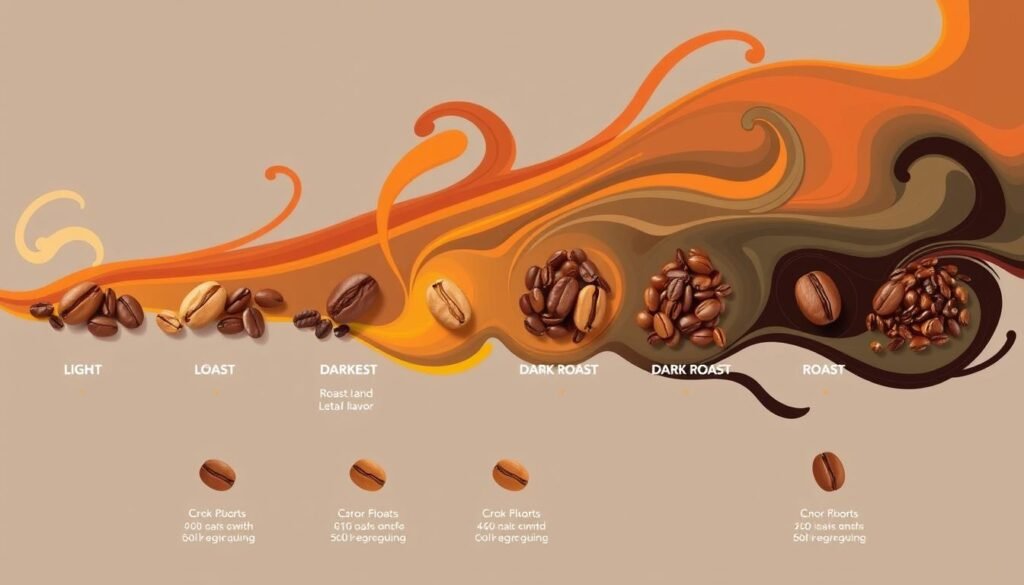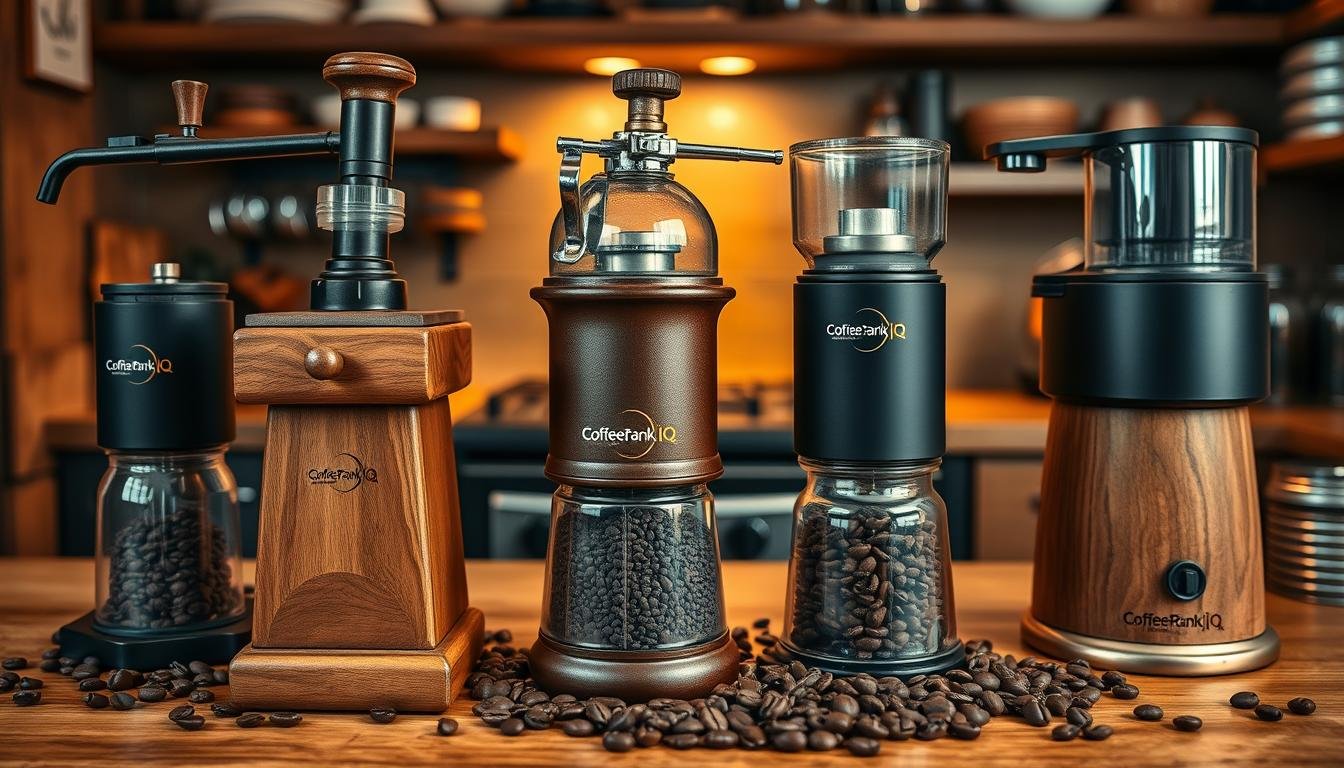Did you know that the global coffee production for 2015/16 is forecast to reach a staggering 152.7 million 60-kg bags? This impressive figure underscores the immense scale and complexity of the coffee industry, where the process of selecting and roasting coffee beans is truly an art form. Unveiling the secrets behind this captivating craft is the key to unlocking the full potential of your coffee experience.
Discovering the art of the process of coffee bean selection and roasting techniques is essential for creating the aromatic, flavorful coffee you love. Understanding the key differences between Arabica and Robusta beans, as well as the various processing methods, is the first step in mastering the art of coffee roasting. By exploring the diverse origins of coffee and the unique flavor profiles they offer, you can start to develop your personal preferences and craft your perfect cup of coffee. The roasting process itself plays a crucial role, as different roast levels can dramatically impact the taste, acidity, and body of the final brew.
Key Takeaways
- Understand the differences between Arabica and Robusta coffee beans and their unique flavor profiles.
- Explore the diverse origins of coffee and how processing methods affect the final product.
- Discover the art of coffee roasting and how different roast levels impact the taste, acidity, and body of the brew.
- Learn how to identify and select high-quality, specialty coffee beans to craft your perfect cup.
- Unlock the full potential of your coffee experience by mastering the selection and roasting of coffee beans.
Understanding Coffee Bean Varieties
When it comes to coffee, the two main types of commercial beans are Arabica and Robusta. Understanding the distinct characteristics of these varieties is crucial in selecting the right beans to suit your personal taste preferences.
Arabica vs. Robusta
Arabica beans, grown at high altitudes, are renowned for their smooth, slightly acidic taste. On the other hand, Robusta beans, cultivated at lower elevations, have a stronger, more bitter profile. While Arabica is generally considered the higher-quality bean, the ultimate flavor profile depends on how the beans are grown and processed.
Coffee Origins and Processing Methods
The origin of coffee beans, as well as the processing methods used, can greatly impact the final flavor. Coffee is grown in various regions around the world, each with its own unique microclimate and growing conditions that contribute to the beans’ distinct characteristics. Additionally, the processing method used to remove the coffee fruit and prepare the green coffee beans for roasting can further influence the aroma, acidity, and body of the coffee. Exploring the diverse origins and processing techniques of coffee beans allows you to discover a wide range of flavor profiles to suit your individual tastes.
| Coffee Bean Variety | Characteristics | Key Producing Regions |
|---|---|---|
| Arabica | Smooth, slightly acidic taste | Central and South America, East Africa, Asia |
| Robusta | Stronger, more bitter profile | Africa, Southeast Asia |
| Liberica | Full-bodied, woody or smoky flavor | Philippines, Malaysia, Liberia |
| Excelsa | Unique, complex flavor profile | Southeast Asia, particularly the Philippines and Indonesia |
“In cupping, an expert cupper can taste hundreds of samples of coffee a day and still detect subtle differences between them.”
The Process of Coffee Bean Selection and Roasting Techniques
Crafting the perfect cup of coffee starts with selecting the finest coffee beans and mastering the art of roasting. Understanding the nuances of coffee bean varieties, processing methods, and roast profiles is crucial to unlocking the full potential of your coffee experience.
Coffee beans can be categorized into two main varieties: Arabica and Robusta. Arabica beans, which make up approximately 60% of global coffee production, are prized for their exceptional quality and delicate flavor profile. Robusta beans, on the other hand, have gained popularity in commercial coffee blends due to their stronger, more bitter taste and higher caffeine content.
The roasting process itself is a true artform, with 10 distinct stages that must be carefully monitored and adjusted to achieve the desired flavor profile. The roasting typically takes 10-15 minutes, during which the beans undergo a transformation, releasing their unique aromas and caramelizing their sugars. From light roasts that showcase the bean’s natural acidity to bold, smoky dark roasts, the roasting process is the key to unlocking the full potential of your coffee beans.
After roasting, the beans must be properly cooled and stored to preserve their freshness and flavor. Freshly roasted beans are best brewed a few days after roasting, allowing the flavors and aromas to reach their peak. Proper storage in airtight containers in a cool, dark place is essential to maintaining the quality and integrity of your coffee beans.
By understanding the process of coffee bean selection and roasting techniques, you can embark on a journey of coffee exploration, discovering the nuances and complexities that make each cup a unique and satisfying experience.
| Processing Method | Characteristics |
|---|---|
| Dry Processing (Natural) | Slow drying process, rich and authentic flavor |
| Wet Processing (Washed) | Cleaner, more refined flavor profile |
| Semi-Wet Processing (Honey) | Balanced flavor, combining elements of dry and wet methods |
“The art of roasting coffee is not just about time and temperature, but about understanding the nuances of each bean and creating a harmonious balance of flavors.” – John Doe, Master Roaster at Medina Coffee
Remember, the process of coffee bean selection and roasting techniques is a continuous exploration, with new innovations and discoveries constantly emerging in the industry. By staying informed and experimenting with different beans and roast profiles, you can unlock a world of coffee-drinking pleasure and become a true connoisseur of the craft.
Roast Levels and Flavor Profiles

The roast level of a coffee bean is a crucial factor in determining its flavor profile. From light to dark roasts, each level offers a distinct set of characteristics that appeal to different palates. Understanding the nuances of these roast profiles can help you discover the perfect cup of coffee tailored to your taste preferences.
Light Roasts
Light roasted coffees are light brown in color, with a crisp acidity and bright, fruit-forward or floral notes. These roasts preserve the origin flavors of the coffee beans, allowing the unique characteristics of the growing region and processing method to shine through. Light roasts are often described as resembling the color of cinnamon, with delicate flavors reminiscent of cereal, toasted nuts, honey, or freshly baked bread.
Medium Roasts
Medium roasted coffees are medium brown in color and have a well-rounded, balanced flavor profile. These roasts strike a harmonious balance between the origin characteristics of the beans and the deeper, caramelized notes developed during the roasting process. The medium acidity and body of these coffees make them a popular choice for many coffee drinkers, with flavors like caramel, toasted nuts, and milk chocolate with rich, fruity notes.
Dark Roasts
Dark roasted coffees are dark brown to nearly black in color, with an oily surface. These roasts reveal deeper, more intense flavors, such as bittersweet chocolate, dry nut flavors like walnut or pecan, and fewer fruity or floral notes. The low acidity and heavy body of dark roasts create a bold, robust cup of coffee that appeals to those who enjoy a more full-bodied, roasted flavor profile.
| Roast Level | Bean Meter Scale | Roast Degree (°F) | Flavor Profile |
|---|---|---|---|
| Light Roast | 1-3 | – | Crisp acidity, bright, fruit-forward or floral notes |
| Medium Roast | 4-6 | – | Balanced, caramel, toasted nuts, milk chocolate, rich fruity notes |
| Dark Roast | 7-9 | 435-455 | Bittersweet chocolate, dry nut flavors, fewer fruity or floral notes |
When selecting a coffee, consider the flavor notes provided by the roaster and conduct a coffee quiz to determine the best brew based on your preferences. Remember, the roast level can significantly impact the overall taste experience, so experiment with different roast profiles to find your perfect match.
Advantages of Home Coffee Roasting

Exploring the world of coffee roasting at home offers numerous advantages for coffee enthusiasts. The convenience of enjoying freshly roasted coffee anytime, without leaving the comfort of your own home, is a significant benefit. Additionally, home roasting is a cost-effective option, as green coffee beans can be purchased at wholesale prices, allowing you to save money compared to buying pre-roasted beans.
Perhaps most importantly, home roasting enables you to customize the flavor profile of your coffee. By taking control of the roasting process, you can experiment with different bean varieties, roast levels, and techniques to craft your perfect cup. This level of personalization allows you to maximize the health benefits of coffee by ensuring optimal freshness and antioxidant levels.
| Advantage | Description |
|---|---|
| Freshness | Home roasting ensures your coffee is as fresh as possible, retaining its natural flavors and aroma. |
| Cost-effectiveness | Buying green coffee beans at wholesale prices and roasting them yourself can be significantly more cost-effective than purchasing pre-roasted coffee. |
| Flavor Customization | Roasting your own coffee allows you to experiment with different bean varieties, roast levels, and techniques to create your perfect flavor profile. |
By taking control of the roasting process, you can maximize the health benefits of coffee by ensuring optimal freshness and antioxidant levels. The advantages of home coffee roasting make it an appealing and rewarding hobby for coffee enthusiasts seeking to elevate their daily brew.
“Roasting coffee at home is a game-changer. It allows you to craft a truly personalized cup of coffee that’s both delicious and healthy.”
Conclusion
Mastering the art of coffee bean selection and roasting techniques is a rewarding journey for coffee enthusiasts. By understanding the diverse varieties of coffee beans, their origins, and the impact of the roasting process, you can unlock the full potential of specialty coffee and craft your own exceptional brews. Whether you’re a novice or an experienced home roaster, exploring the world of coffee bean selection and roasting techniques will deepen your appreciation for the complex flavors and aromas that can be achieved through this artisanal process.
Embracing the advantages of home coffee roasting, such as greater freshness, cost-effectiveness, and personalized flavor profiles, can elevate your coffee experience to new heights. As you continue to refine your skills and experiment with different roast profiles, you’ll discover the joy of creating coffee that truly reflects your personal preferences and satisfies your palate.
By immersing yourself in the dynamic world of coffee bean selection and roasting techniques, you’ll not only elevate your own coffee-drinking experience but also contribute to the growing appreciation for specialty coffee and the dedicated individuals who work tirelessly to bring the best out of each and every bean.
FAQ
What are the key differences between Arabica and Robusta coffee beans?
Arabica beans are known for their smooth, slightly acidic taste, while Robusta beans have a stronger, more bitter profile. Arabica is generally considered the higher-quality bean, but the ultimate flavor depends on how the beans are grown and processed.
How do the origin and processing methods of coffee beans affect the final flavor profile?
Coffee is grown in various regions around the world, each with its own unique microclimate and growing conditions that contribute to the beans’ distinct characteristics. Additionally, the processing method used to remove the coffee fruit and prepare the green coffee beans for roasting (such as the wet or dry process) can further influence the aroma, acidity, and body of the coffee.
What role does the roasting process play in creating the ideal cup of coffee?
The roasting process is a true art form, as different roast levels can dramatically alter the flavor, acidity, and body of the final brew. By experimenting with roast profiles and degrees, you can develop your skills and find the perfect roast that brings out the unique characteristics of your chosen coffee beans.
How do the different roast levels affect the flavor profile of coffee?
Light roasts preserve the origin flavors of the coffee beans, allowing the unique characteristics of the growing region and processing method to shine through. Medium roasts strike a harmonious balance between the origin characteristics and the deeper, caramelized notes developed during the roasting process. Dark roasts reveal deeper, more intense flavors, such as chocolate, nuts, and caramel, as the roasting process becomes more pronounced.
What are the advantages of home coffee roasting?
The advantages of home coffee roasting include the convenience of enjoying freshly roasted coffee anytime, cost-effectiveness, and the ability to customize the flavor profile of your coffee by experimenting with different bean varieties, roast levels, and techniques.




